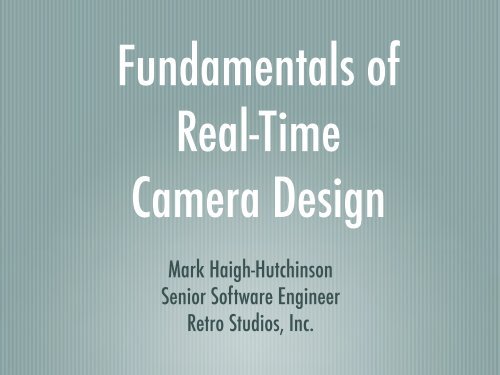Mark Haigh-Hutchinson Senior Software Engineer Retro Studios, Inc.
Mark Haigh-Hutchinson Senior Software Engineer Retro Studios, Inc.
Mark Haigh-Hutchinson Senior Software Engineer Retro Studios, Inc.
Create successful ePaper yourself
Turn your PDF publications into a flip-book with our unique Google optimized e-Paper software.
Fundamentals of<br />
Real-Time<br />
Camera Design<br />
<strong>Mark</strong> <strong>Haigh</strong>-<strong>Hutchinson</strong><br />
<strong>Senior</strong> <strong>Software</strong> <strong>Engineer</strong><br />
<strong>Retro</strong> <strong>Studios</strong>, <strong>Inc</strong>.
<strong>Mark</strong> <strong>Haigh</strong>-<strong>Hutchinson</strong><br />
21 years in the games industry<br />
40+ published titles<br />
Programmer / Designer / Project Leader<br />
Camera systems and player controls<br />
Metroid Prime<br />
Metroid Prime 2:Echoes
Agenda<br />
Why talk about camera design?<br />
To raise awareness<br />
Avoidable camera problems persist<br />
Small amount of literature<br />
Set a high standard
Topics<br />
Camera System Overview<br />
Camera Fundamentals<br />
Game Genre Cameras<br />
Camera Design Principles<br />
Player Control<br />
Camera Design Process<br />
Camera Design Questions
Camera System<br />
Overview
Camera System Overview<br />
Controls game presentation<br />
Defines main interface of game<br />
Real-time and cinematic sequences<br />
Services other game systems<br />
Uses general and specific solutions<br />
Allows designers to override behaviors
Camera System Goals<br />
Present best view of game play<br />
Avoid player frustration<br />
Be unobtrusive<br />
Prevent disorientation<br />
Allow player control as appropriate
Camera Fundamentals
Camera Fundamentals<br />
What do we mean by a camera?<br />
Defines a view of the game world<br />
Does not usually simulate real camera properties<br />
Many different types of cameras<br />
Cinematic or Interactive
Camera Types<br />
Cinematic Interactive<br />
Pre-defined behavior<br />
Aesthetics over game play<br />
Established conventions<br />
Well-defined situations<br />
Dynamic behavior<br />
Game play over aesthetics<br />
Conventions being defined<br />
Wide variety of situations
Camera Properties<br />
Presentation style (Projection)<br />
Type (First, Third person)<br />
Behavior<br />
Desired position<br />
Motion type<br />
Look-At position<br />
Orientation method
First Person Camera<br />
Viewed from player<br />
Limited Field-Of-View<br />
Positioning is difficult<br />
Aiming is easy<br />
Limited character view<br />
Very immersive
Third Person Camera<br />
External to player<br />
Positioning easier<br />
Aiming more difficult<br />
Less immersive<br />
Navigation problems<br />
Framing problems
Camera Motion<br />
Desired position<br />
Motion types<br />
Stationary<br />
Slaved<br />
Path constrained<br />
Surface constrained<br />
Motion method
Camera Orientation<br />
Look-At position<br />
Object tracking<br />
Object framing<br />
Path tracking<br />
Orientation lag<br />
Free-look
Game Genre Cameras<br />
Part 1
Game Genre Cameras<br />
Genre-specific camera types<br />
Game play requirements more important<br />
Multiple camera types often required<br />
Split-screen multi-player presents additional challenges
Action-Adventure<br />
Motion and orientation lag<br />
Elevated position<br />
Look-at depends on action<br />
Generalized solution difficult<br />
Minimize reorientation
3D Platform<br />
Elevated position<br />
Often pre-defined path or position<br />
Environment view most important<br />
User control override preferred
Flight Simulation<br />
Requires multiple viewpoints<br />
Roll is permissible<br />
Look-at position ahead of craft<br />
Replay cameras
Racing<br />
Multiple viewpoints<br />
Defined camera paths<br />
Motion and orientation lag<br />
Replay cameras
Camera Design<br />
Principles
Camera Design Principles<br />
Avoid player character occlusion<br />
Navigate environment automatically<br />
Allow camera manipulation<br />
Do not REQUIRE camera manipulation<br />
Minimize camera motion<br />
Ensure motion is smooth
Camera Design Principles<br />
Limit reorientation speed<br />
Limit use of roll<br />
Lead a character in motion<br />
Preserve player intent<br />
Seamless transitions
Player Control
Player Control<br />
Linked to camera system<br />
Genre & controller dependent<br />
Consistency of control<br />
Can be automated<br />
Abstracted to commands<br />
Control Reference Frame
Control Reference Frame<br />
Maps player controls to character motion<br />
Abrupt changes frustrate<br />
Retain after instant or rapid motion<br />
Game play and genre dependent
Control Reference Frame<br />
Character-relative : Problematic in third person<br />
Camera-relative : Player proximity issues<br />
World-relative : Controls are consistent<br />
Screen-relative : Motion defined by camera view<br />
Object-relative : Inscribes a motion arc (”lock-on”)
Game Genre Cameras<br />
Part 2
Game Genre Cameras<br />
Camera choice can be difficult<br />
Player perception linked to camera type<br />
Not restricted to “traditional” choices<br />
Experimentation is encouraged
Fighting<br />
Must frame multiple characters<br />
Focal point between enemies<br />
Open environments<br />
Cinematic approach
Role Playing Games<br />
Elevated, distant position<br />
Often entirely user controlled<br />
Combat may use stationary view<br />
Navigation difficulties
Sports<br />
Matches TV presentation style<br />
Multiple viewpoints<br />
Elevated positions mostly<br />
Replay cameras
Camera Design<br />
Process
Camera Design Process<br />
Important part of entire game design<br />
Requires dedicated staff<br />
Prototype and iterate early<br />
Derive from game play and environments
Camera Design Process<br />
Overview<br />
Examine high level design goals<br />
Evaluate player character abilities<br />
Determine scope of environments<br />
Define base camera behavior(s)<br />
Determine area-specific requirements<br />
Technical evaluation of cameras
Camera Design Process<br />
Per Area<br />
Determine specific environment needs<br />
Specify game play / AI / game objects<br />
Prototype simplest solution<br />
Refine once game play fixed
Camera Design<br />
Questions
Camera Design Questions<br />
Player Abilities and Controls<br />
Consider all character movement properties<br />
Has the motion been finalized?<br />
Any ranged interactions?<br />
Do the player abilities change over time?<br />
Are control changes necessary?<br />
Simplify or restrict controls?<br />
Camera manipulation allowed?
Camera Design Questions<br />
Environmental Concerns<br />
Sufficient space for camera motion / framing?<br />
Single presentation style?<br />
Will interpolation methods work?<br />
Removal or fading possible to avoid occlusion?
Camera Design Questions<br />
Aesthetics<br />
Character framing?<br />
Aiming or ranged interactions?<br />
Is orientation or motion lag required?<br />
Does occlusion matter?<br />
Pre-defined or dynamic positioning?
Camera Design Questions<br />
Technical considerations<br />
Object or geometry transparency?<br />
Rendering issues outside world<br />
Dynamic camera behaviors?<br />
Camera specific collision detection & avoidance?<br />
Tools to specify camera behaviors<br />
Camera debugging facilities?
Conclusions
Conclusions<br />
Camera design greatly impacts game play<br />
Essential part of the overall game design task<br />
Requires dedicated development staff<br />
Player control linked to camera design<br />
No single camera solution<br />
Prototype early and design away problems<br />
Successful camera systems are unobtrusive
Conclusions<br />
No-one will notice if you truly succeed
Further Reading
Further Reading<br />
Game Programming Gems Series, Volumes 1, 2, & 4<br />
AI Game Programming Wisdom Series, Volumes 1 & 2<br />
Real-Time Cinematography for Games - Brian Hawkins<br />
GDC 2004 Proceedings<br />
Full Spectrum Warrior Camera System - John Giors<br />
Grammar of the Film Language - Daniel Arijon
Forthcoming Book<br />
Real-Time Cameras<br />
Written by <strong>Mark</strong> <strong>Haigh</strong>-<strong>Hutchinson</strong><br />
Published by Morgan Kaufmann<br />
Series in Interactive 3D Technology<br />
www.mkp.com<br />
www.realtimecameras.com
One Last Thing...
Thanks!<br />
GDC 2005 Selection Committee<br />
John Giors, Ryan Harris, Akintunde Omitowoju, Kynan Pearson
Contact Info<br />
mhh@computer.org<br />
www.realtimecameras.com



